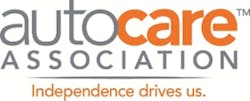The Auto Care Association is officially unveiling its Secure Vehicle Interface (SVI) at the upcoming Automotive Aftermarket Products Expo (AAPEX), with live demonstrations of the new standardized technical design for providing secure access to in-vehicle networks by both vehicle owners and aftermarket service providers.
The Association is working with Q-Free; Concepts & Services Solutions (CSC); OnBoard Security; Green Hills Software/Integrity Security Services (GHS/ISS); and CarMD/Innova will showcase three separate demonstrations to highlight how the new technology enables secure and direct access to vehicle data.
OEMs are increasingly citing security threats as a reason to further restrict access to vehicle data by third parties. With the SVI, the aftermarket hopes to provide a platform (based on international standards) for securely accessing that data in a way that addresses legitimate automaker and consumer concerns while also ensuring continued vehicle access for repairers and other organizations.
"This interface provides a consistent communication interface for collecting and reporting vehicle data to ensure interoperable, safe and secure operation," says Gangolf Feiter, founder of CSC. "SVI also provides a secure direct connection to vehicle network systems for certificate-based, authorized third parties, ensuring the integrity of the data being transmitted to properly complete vehicle maintenance and repair."
The SVI has been in development for several years, and represents a collection of roughly 25 individual standards defined by standards bodies including ISO, IEEE and SAE.
“We see this as being a standard that can be applied to new car architectures, so that it can be employed in a new car or in legacy retrofit systems,” says Joe Register, vice president of emerging technologies at the Auto Care Association. “The standards are equally applicable in both domains.”
Secure, standardized vehicle access will be critical for future vehicle-to-infrastructure or vehicle-to-vehicle communications, as well for repairer data access. “There is a fair amount of risk if the aftermarket loses its direct access,” Register says. “SVI provides a safe, secure and standardized manner for communication, so that vehicle manufacturers can focus on other bells and whistles. This takes the burden off each individual OE to design a conforming interface. That piece can be accomplished by following the ISO standards for ITS.”
AAPEX attendees will see three different SVI demonstrations during the conference including:
- A demonstration of a live, secure connection to the in-vehicle network of a 2018 Dodge Charger sing the Open Driving Platform (ODP) to monitor and diagnose the vehicle. The SVI-enabled interface will allow for the reporting of roadworthiness, diagnostics, and the generation of emergency notifications while the vehicle is in motion.
- There will be secure intelligent transport system (ITS) stations positioned on the Las Vegas Strip that will allow attendees to see live monitoring and vehicle health data, including traffic, speed, geolocation, and other information.
- Another demo will present ITS connectivity with transportation network infrastructure. Shuttle bus passengers will be able to access real-time arrival information and traffic conditions based on a secure connection to the shuttle bus fleet via their smart phones.
“We will demonstrate SVI-compliant devices installed in the vehicles, which will be circling the city and reporting and connecting to the ITS stations,” Register says. “There will be equipment installed along the highways in Las Vegas collecting the information.”
Register notes that there is a burgeoning demand for connecting to future intelligent infrastructure in the U.S. “Connecting to that will be increasingly important,” he says. “It can reduce traffic fatalities, make roads safer, and improve the driving experience.”
The diagnostic demo will show how repairers can securely access trouble codes and do more analysis to determine the root cause of a problem. “That’s part of the telematics piece, which is also of interest to other parties,” Register says. “Insurance companies might want to see how you are driving, or get access to information about a car’s fuel mileage. Vehicle owners can monitor how their vehicles are being used. SVI supports that.”
The Auto Care Association is interfacing with OEMs both individually and in the context of the organization's work in various ISO and other standards body committees. “To be honest, many of them are already using the standards that are part of SVI in vehicles that are already in production,” Register says. “Adoption is not a difficult thing for them to accomplish. In some cases, it’s just changing the programming of a chip.”
OEMs do have a commercial interest in restricting access to valuable vehicle information. “But you need to have direct access to the vehicle to support ITS,” Register says. “To disrupt the flow of information to serve a particular business plan takes you out of the technology sector and into conversations about whether or not that is appropriate at a competitive level. With SVI in place, they don’t have the excuse of security to block access.”
The Auto Care Association is also working with other stakeholders in the ITS sector about securing the various types of data that can be sent across that infrastructure, and how much control vehicle owners should have over what data OEs and other parties have access to. “Everybody wants more information, but the owner should know what is being sent and have some control over that,” Register says. “One concern we’re working on is the amount of biometric information available from the vehicle. The size of the person in the seat makes a difference in the way crash protection is employed, for example, but that information is also available for communication and some of it is flowing through the OE infrastructure today.”
SVI will be on display at the Auto Care SVI Booth (31021) in the Technology of Tomorrow section of the conference at the Venetian Hotel. There will also be educational conference sessions on the ITS infrastructure and the opportunities that presents for the aftermarket, as well as a session about SVI.


